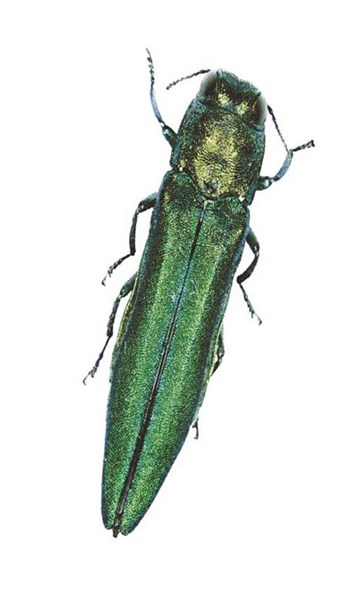
Metallic green in color and measuring just a half-inch long and an eighth-of-an-inch wide, the emerald ash borer, a beetle native to Asia and first discovered in Michigan in 2002, has been responsible for the deaths of hundreds of millions of ash trees in North America. The damage inflicted by the insect has reportedly run into the hundreds of millions of dollars. Who knew that such a tiny insect could wreak so much havoc throughout the country.
But wreak havoc it does. The EAB is now present in about 28 states, including Illinois, where according to the state's Department of Agriculture it was found in 2006—and if the invasion is not dealt with, the costs could reach into the billions of dollars, according to the Emerald Ash Borer Information Network (http://www.emeraldashborer.info/).
Emerald Ash Origins
The city of Chicago, which had its first confirmed case of emerald ash borer in 2008, says that ash trees make up 17 percent of the city's street tree population, or about 85,000 individual trees. And that number isn't counting the 300,000 ash trees growing on private property. Last year, Illinois announced it would drop its internal emerald ash borer quarantine, but that 10 additional counties had detected the shiny menace within their borders, bringing up the total count of affected counties to 60.
“It happened really quickly,” says Tom Tiddens, a supervisor in the plant care department of the Chicago Botanic Garden. “I've been watching this for a number of years. We found it in Illinois, then all of a sudden we found it in the next town over, and all of a sudden it was found on the next block. We thought we were going have some years to deal with this, but we saw how fast it was happening. We had to gear up really quickly.”
How It Began
It is suspected that the emerald ash borer arrived in North America via wood packing crates from Asia, says Tiddens. Interestingly, on its home turf the insect infests ash trees, but does not kill them. So why do U.S. trees fare so badly when they tangle with the EAB? “I think we have determined it has to do with the fact that the ash borer evolved in Asia along with the ash trees,” Tiddens says, “and those trees have developed some sort of defense, while ash trees in the U.S. have not. And that's what everybody's trying to figure out: How are the Asian trees different than the ones over here?”
The spread of the EAB can be attributed to two things, according to plant and pest pros: its own tendency to wander widely—up to a mile and a half per year—and the tendency of people to unwittingly help it. “It really takes just one person on a camping trip to decide, 'Oh, I spent $4 on that bundle of wood. I'm going to take it home with me,'” says Tiddens. “Or say if I went to my backyard and cut down an ash tree and I want to go camping in another state and I was to bring that wood. That's the main way it's been jumping around—just the movement of wood.”
Sherman Fields, the vice president of Acres Group, a landscaping company with offices in Wauconda, Plainfield and Roselle, explains what happens once the emerald ash borer lands on an ash tree: “It burrows into the tree, just under the bark and into the cambium layer. It feeds within that layer, which creates tunnels. The tree works like a human body; it has a vascular system. The roots draw water and nutrients in, and they're transported up the tree. So when EABs tunnel throughout that layer, it just cuts off those pathways, and the tree literally starves to death. When you first see any sign at all, it’s up at the top of the tree, and what you'll see is dieback, or dead branches. Once that starts, within the next the 2-3 years, that tree is dead.”
Effects on Ash Trees
Beyond just the sad destruction of individual trees, EAB infestation has serious environmental consequences. “Trees are a great filter for a lot of pollutants, such as carbon,” says Fields, “and roughly one tree will negate the effects of one automobile's pollution—so that's kind of a big deal. And if you put a shade tree next to your home, it will help keep it cooler in the summer, warmer in the winter, so it does have an impact there.”
And then there is also the financial impact when it comes to removing and replacing a tree. “It's hard to place a value on a mature tree,” says Fields, “because you can't plant a mature tree. You have to start with a modest sized shade tree—say one with a 2-and-a-half-inch trunk. Depending on the species, those are being installed in the market at anywhere from $400 to $600 dollars per tree. So if a million ash trees in Chicagoland are destroyed, to replace them at a smaller size, say at $500 each, that's $500 million. That's a lot of money.”
While towns and municipalities will likely feel the bite of tree replacement costs most keenly on account of being responsible for planting and maintaining so many trees, the EAB's financial repercussions can also impact homeowners and condo owners. “Ash trees were probably providing shade to various units and buildings that cut down electric costs for cooling,” says David Froede, an arborist representative at the Northbrook office of Bartlett Tree Experts.
“It can be very dramatic for a single family home to lose a large tree in the backyard, but that loss would also apply to condo units and multifamily buildings as well. From an economic standpoint, that aesthetic factor can be very important. A number of large, well-placed, healthy trees can certainly dramatically increase value of a property. And to not have the aesthetic appeal that a mature tree contributes, the value of property could go down.”
To Treat or To Cut?
Tiddens says that once the EAB is spotted within about 15 miles of a community, it’s time to either start treating the area's ash trees, or to budget for their removal. “When it happens, it happens fast,” he says of the insect’s infestation. “And one thing that we learned from ash trees as a species is that once they die, their wood quickly becomes very brittle, and they become hazards. That's why it's been difficult for municipalities - they can't leave those dead trees standing, because those limbs will start breaking very quickly.”
Whatever a board or an association decides to do, it is going to be a costly endeavor. “You can do some cost assessments on how much it's going to cost to treat these trees for a few years as opposed to taking them down,” says Tiddens. “Takedowns can be very expensive, especially when they are near buildings. So you can balance that against the cost of treatment - but these treatments need to be made every other year, and they're not cheap either. So a lot of times you're striking a middle ground.”
Among the treatment options available to protect the ash tree from EAB attack is to inject tree trunks with a chemical that wipes out EAB larvae. If an EAB lays eggs on a treated tree, Tiddens says, the larvae may bore into the trunk, but upon encountering the chemical, they quickly die, “And basically your tree is pretty well protected.”
“But,” Tiddens continues, “you really need to start these treatments before the tree is attacked. We've tried some treatments after the trees have already been infected to a certain point, and we ended up having to remove those trees. If you're in the state of Illinois and you have ash trees, and the emerald ash borer hasn't hit you yet, you should make a decision pretty quickly on which direction you want to go [prevention or removal] because it's pretty much inevitable that the EAB wave will come through. So protect your trees—or be prepared to take them down.”
Froede says that in the past, his company has been called to multifamily complexes to assess ash trees that were already showing signs of decline. “When we get called in, it's often after the fact. Depending on the level of the infestation and how much damage is done, we can either save the tree, or if it's too late, we often have to remove it.”
Fields suggests that unless it’s a very special tree that has personal sentimental value, an ash tree at risk for EAB infestation should be removed, period. “The reason is really two-fold,” he explains. “First is economic. If you treat, you have to treat forever. If you weigh the cost of treating the tree forever versus removal and replacement, it's more cost effective to remove and replace it with a different type of tree.”
Diversification & Resources
Most tree and plant care professionals advise community associations to conduct a tree inventory on their property to determine which trees are of high value and at risk, and which ones can be removed.
Another common refrain from the experts is to diversify the tree species that are planted or replanted on a given property, so that if a species-specific threat should arise, it won't wipe out every tree in the association. “The more you diversify, the less risk you have,” says Fields. “Plus it's great to have different kinds of trees for different kinds of interests.”
Froede agrees. “One of the issues I've seen with the emerald ash borer—to some degree with condo associations, but more with municipalities—is that they just planted street after street with ash trees. And then the ash trees are all declining because of emerald ash borer, and now they're having to remove them. Diversification is important.”
According to the Emerald Ash Borer Network, agencies and universities are working together to educate the public about how to identify the insect and ash trees as well as treatment options. There are a number of resources for those concerned about EABs in their communities. The Illinois Department of Agriculture has a section on their website (https://www.agr.state.il.us/eab/) devoted to the insects, and a phone number 815-787-5481 you can call with questions. Those in Chicago proper can call 311, or the city's Beetle Hotline at 312-742-3385 if they suspect the insect in their areas. And the Chicago Botanic Garden has section on its website about which trees to plant to replace an ash (http://www.chicagobotanic.org/plantinfo/ash_tree_alternatives).
When it comes to strategizing about your own HOA's response to the EAB menace, “The other advice I would share,” says Fields, “is to do a multiyear plan to remove and replace ash trees. Work with a landscaper or nursery...to figure out trees that you'd like to replant with. Once you select the trees, understand where those trees will perform best. If trees are going to go close to the foundation of a home, you don't want something that’s going to be growing into your home or be too large for the space that is there for it. Go over that with a knowledgeable professional, because it's a big investment.”
As for the future of the battle against the EAB, “There's a lot of research being done on predatory insects that has been finding mixed success,” says Tiddens. “But they found that it is working, they're slowing down the spread a little bit. And there is some breeding work being done to find an ash tree that is going to be resistant to this pest They've gone to the extent of going over to Asia collecting seeds and samples and trying to do some breeding. There is some hope down the road that we may find an ash tree that is resistant to emerald ash borer, but we're dealing with trees, it's a not a quick thing to do...it's such a slow process.”
David Chiu is an associate editor at The Chicagoland Cooperator.






Leave a Comment